UK Public Health Intervention: HIV, Theories, Policies & Nurse's Role
VerifiedAdded on 2023/06/11
|10
|3364
|482
Report
AI Summary
This report examines public health interventions in the UK related to HIV, focusing on the London borough of Brent. It discusses the prevalence of HIV, the impact of undiagnosed cases, and the implementation of the Health Belief Model. The report analyzes existing UK policies and their effectiveness in prevention, testing, treatment, and social support. Various interventions, including awareness campaigns, expanded testing, and addressing stigma, are explored. Health promotion models, such as the ecological model, are examined in the context of HIV prevention, along with the roles of nursing professionals in patient education, healthcare process, and emotional support. The report highlights the importance of multi-faceted approaches to combat HIV and improve public health outcomes. Desklib offers a wealth of resources, including past papers and solved assignments, to support students in their studies.

AUX Public Health in
Action
Action
Paraphrase This Document
Need a fresh take? Get an instant paraphrase of this document with our AI Paraphraser

Table of Content.
INTRODUCTION...........................................................................................................................1
MAIN BODY..................................................................................................................................1
CONCLUSION................................................................................................................................5
REFERENCES................................................................................................................................7
INTRODUCTION...........................................................................................................................1
MAIN BODY..................................................................................................................................1
CONCLUSION................................................................................................................................5
REFERENCES................................................................................................................................7
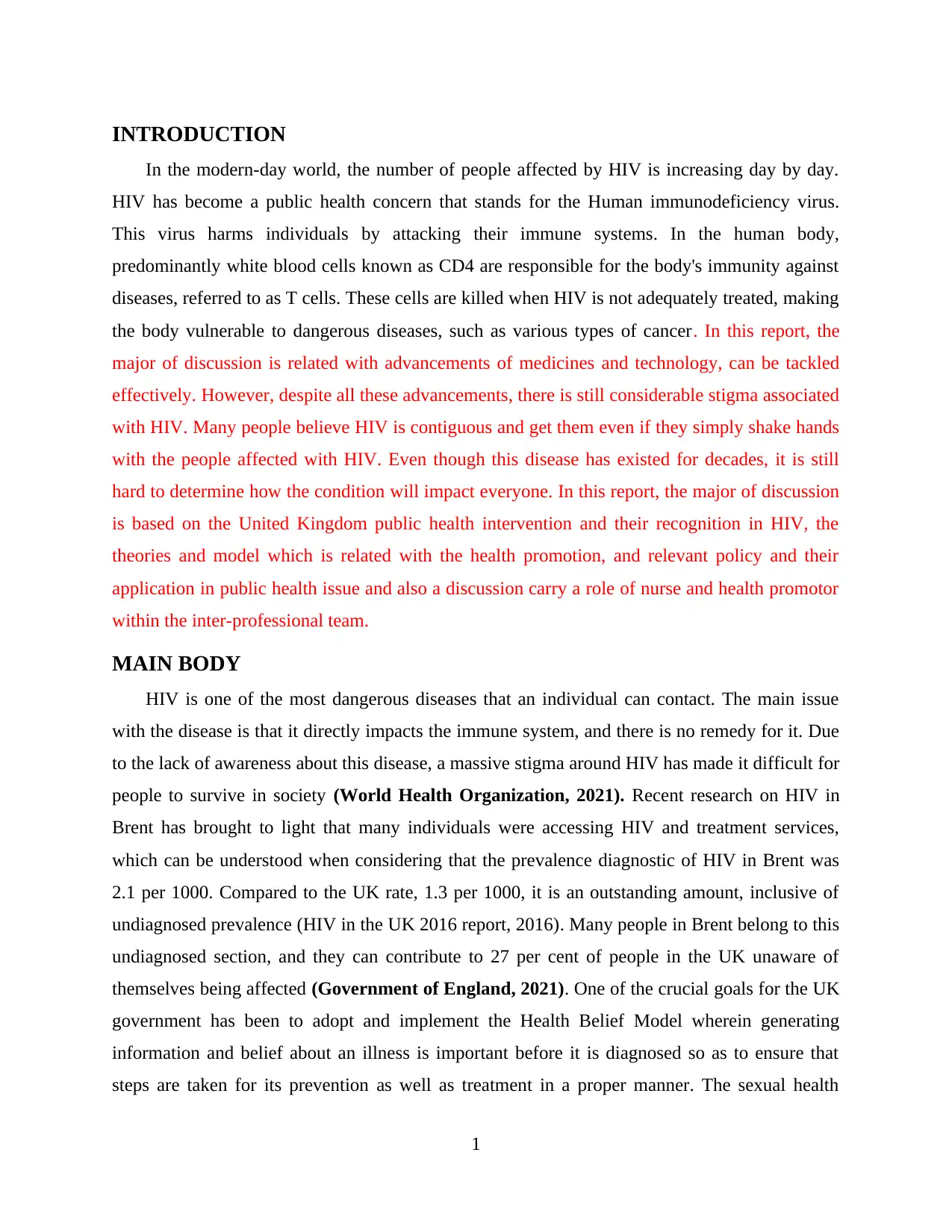
INTRODUCTION
In the modern-day world, the number of people affected by HIV is increasing day by day.
HIV has become a public health concern that stands for the Human immunodeficiency virus.
This virus harms individuals by attacking their immune systems. In the human body,
predominantly white blood cells known as CD4 are responsible for the body's immunity against
diseases, referred to as T cells. These cells are killed when HIV is not adequately treated, making
the body vulnerable to dangerous diseases, such as various types of cancer. In this report, the
major of discussion is related with advancements of medicines and technology, can be tackled
effectively. However, despite all these advancements, there is still considerable stigma associated
with HIV. Many people believe HIV is contiguous and get them even if they simply shake hands
with the people affected with HIV. Even though this disease has existed for decades, it is still
hard to determine how the condition will impact everyone. In this report, the major of discussion
is based on the United Kingdom public health intervention and their recognition in HIV, the
theories and model which is related with the health promotion, and relevant policy and their
application in public health issue and also a discussion carry a role of nurse and health promotor
within the inter-professional team.
MAIN BODY
HIV is one of the most dangerous diseases that an individual can contact. The main issue
with the disease is that it directly impacts the immune system, and there is no remedy for it. Due
to the lack of awareness about this disease, a massive stigma around HIV has made it difficult for
people to survive in society (World Health Organization, 2021). Recent research on HIV in
Brent has brought to light that many individuals were accessing HIV and treatment services,
which can be understood when considering that the prevalence diagnostic of HIV in Brent was
2.1 per 1000. Compared to the UK rate, 1.3 per 1000, it is an outstanding amount, inclusive of
undiagnosed prevalence (HIV in the UK 2016 report, 2016). Many people in Brent belong to this
undiagnosed section, and they can contribute to 27 per cent of people in the UK unaware of
themselves being affected (Government of England, 2021). One of the crucial goals for the UK
government has been to adopt and implement the Health Belief Model wherein generating
information and belief about an illness is important before it is diagnosed so as to ensure that
steps are taken for its prevention as well as treatment in a proper manner. The sexual health
1
In the modern-day world, the number of people affected by HIV is increasing day by day.
HIV has become a public health concern that stands for the Human immunodeficiency virus.
This virus harms individuals by attacking their immune systems. In the human body,
predominantly white blood cells known as CD4 are responsible for the body's immunity against
diseases, referred to as T cells. These cells are killed when HIV is not adequately treated, making
the body vulnerable to dangerous diseases, such as various types of cancer. In this report, the
major of discussion is related with advancements of medicines and technology, can be tackled
effectively. However, despite all these advancements, there is still considerable stigma associated
with HIV. Many people believe HIV is contiguous and get them even if they simply shake hands
with the people affected with HIV. Even though this disease has existed for decades, it is still
hard to determine how the condition will impact everyone. In this report, the major of discussion
is based on the United Kingdom public health intervention and their recognition in HIV, the
theories and model which is related with the health promotion, and relevant policy and their
application in public health issue and also a discussion carry a role of nurse and health promotor
within the inter-professional team.
MAIN BODY
HIV is one of the most dangerous diseases that an individual can contact. The main issue
with the disease is that it directly impacts the immune system, and there is no remedy for it. Due
to the lack of awareness about this disease, a massive stigma around HIV has made it difficult for
people to survive in society (World Health Organization, 2021). Recent research on HIV in
Brent has brought to light that many individuals were accessing HIV and treatment services,
which can be understood when considering that the prevalence diagnostic of HIV in Brent was
2.1 per 1000. Compared to the UK rate, 1.3 per 1000, it is an outstanding amount, inclusive of
undiagnosed prevalence (HIV in the UK 2016 report, 2016). Many people in Brent belong to this
undiagnosed section, and they can contribute to 27 per cent of people in the UK unaware of
themselves being affected (Government of England, 2021). One of the crucial goals for the UK
government has been to adopt and implement the Health Belief Model wherein generating
information and belief about an illness is important before it is diagnosed so as to ensure that
steps are taken for its prevention as well as treatment in a proper manner. The sexual health
1
⊘ This is a preview!⊘
Do you want full access?
Subscribe today to unlock all pages.

Trusted by 1+ million students worldwide
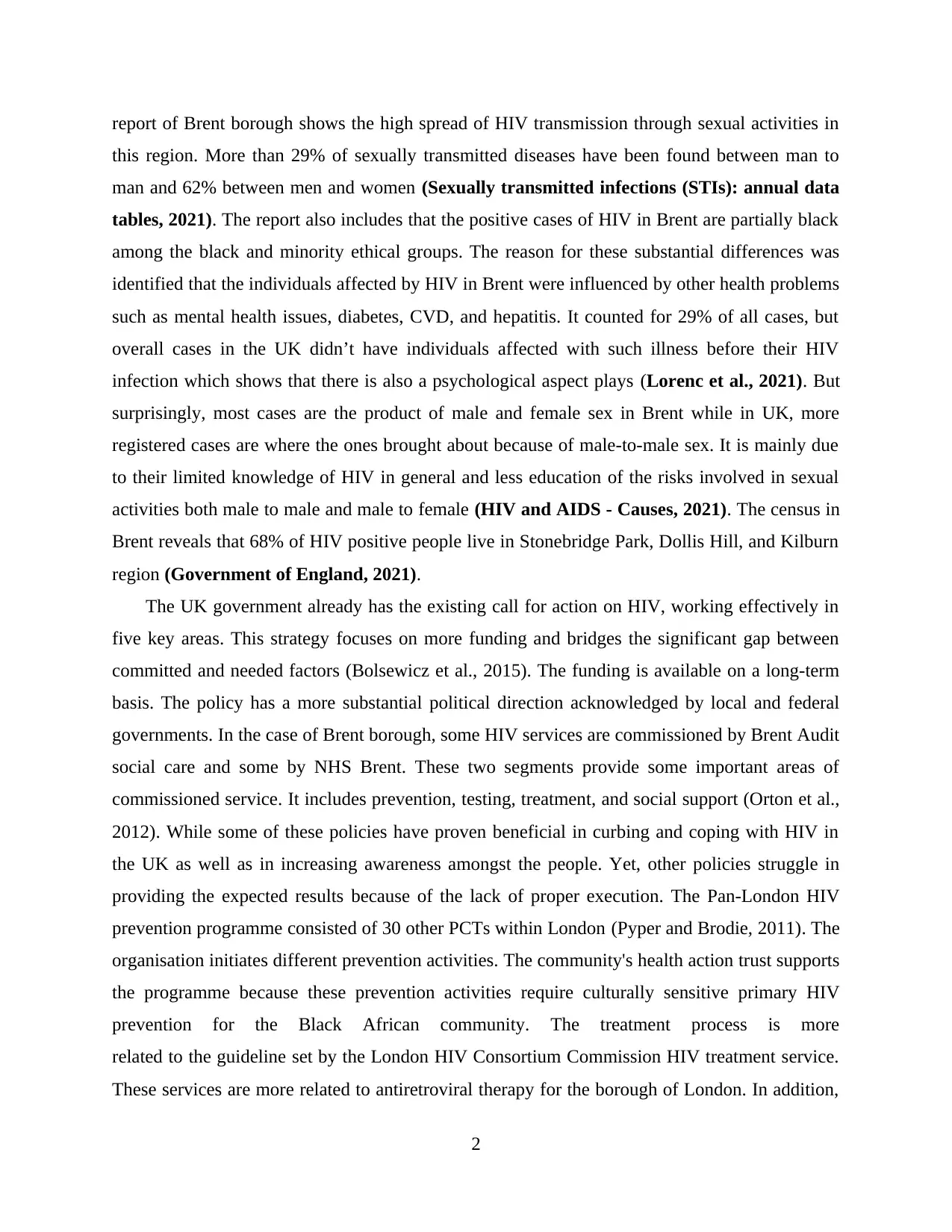
report of Brent borough shows the high spread of HIV transmission through sexual activities in
this region. More than 29% of sexually transmitted diseases have been found between man to
man and 62% between men and women (Sexually transmitted infections (STIs): annual data
tables, 2021). The report also includes that the positive cases of HIV in Brent are partially black
among the black and minority ethical groups. The reason for these substantial differences was
identified that the individuals affected by HIV in Brent were influenced by other health problems
such as mental health issues, diabetes, CVD, and hepatitis. It counted for 29% of all cases, but
overall cases in the UK didn’t have individuals affected with such illness before their HIV
infection which shows that there is also a psychological aspect plays (Lorenc et al., 2021). But
surprisingly, most cases are the product of male and female sex in Brent while in UK, more
registered cases are where the ones brought about because of male-to-male sex. It is mainly due
to their limited knowledge of HIV in general and less education of the risks involved in sexual
activities both male to male and male to female (HIV and AIDS - Causes, 2021). The census in
Brent reveals that 68% of HIV positive people live in Stonebridge Park, Dollis Hill, and Kilburn
region (Government of England, 2021).
The UK government already has the existing call for action on HIV, working effectively in
five key areas. This strategy focuses on more funding and bridges the significant gap between
committed and needed factors (Bolsewicz et al., 2015). The funding is available on a long-term
basis. The policy has a more substantial political direction acknowledged by local and federal
governments. In the case of Brent borough, some HIV services are commissioned by Brent Audit
social care and some by NHS Brent. These two segments provide some important areas of
commissioned service. It includes prevention, testing, treatment, and social support (Orton et al.,
2012). While some of these policies have proven beneficial in curbing and coping with HIV in
the UK as well as in increasing awareness amongst the people. Yet, other policies struggle in
providing the expected results because of the lack of proper execution. The Pan-London HIV
prevention programme consisted of 30 other PCTs within London (Pyper and Brodie, 2011). The
organisation initiates different prevention activities. The community's health action trust supports
the programme because these prevention activities require culturally sensitive primary HIV
prevention for the Black African community. The treatment process is more
related to the guideline set by the London HIV Consortium Commission HIV treatment service.
These services are more related to antiretroviral therapy for the borough of London. In addition,
2
this region. More than 29% of sexually transmitted diseases have been found between man to
man and 62% between men and women (Sexually transmitted infections (STIs): annual data
tables, 2021). The report also includes that the positive cases of HIV in Brent are partially black
among the black and minority ethical groups. The reason for these substantial differences was
identified that the individuals affected by HIV in Brent were influenced by other health problems
such as mental health issues, diabetes, CVD, and hepatitis. It counted for 29% of all cases, but
overall cases in the UK didn’t have individuals affected with such illness before their HIV
infection which shows that there is also a psychological aspect plays (Lorenc et al., 2021). But
surprisingly, most cases are the product of male and female sex in Brent while in UK, more
registered cases are where the ones brought about because of male-to-male sex. It is mainly due
to their limited knowledge of HIV in general and less education of the risks involved in sexual
activities both male to male and male to female (HIV and AIDS - Causes, 2021). The census in
Brent reveals that 68% of HIV positive people live in Stonebridge Park, Dollis Hill, and Kilburn
region (Government of England, 2021).
The UK government already has the existing call for action on HIV, working effectively in
five key areas. This strategy focuses on more funding and bridges the significant gap between
committed and needed factors (Bolsewicz et al., 2015). The funding is available on a long-term
basis. The policy has a more substantial political direction acknowledged by local and federal
governments. In the case of Brent borough, some HIV services are commissioned by Brent Audit
social care and some by NHS Brent. These two segments provide some important areas of
commissioned service. It includes prevention, testing, treatment, and social support (Orton et al.,
2012). While some of these policies have proven beneficial in curbing and coping with HIV in
the UK as well as in increasing awareness amongst the people. Yet, other policies struggle in
providing the expected results because of the lack of proper execution. The Pan-London HIV
prevention programme consisted of 30 other PCTs within London (Pyper and Brodie, 2011). The
organisation initiates different prevention activities. The community's health action trust supports
the programme because these prevention activities require culturally sensitive primary HIV
prevention for the Black African community. The treatment process is more
related to the guideline set by the London HIV Consortium Commission HIV treatment service.
These services are more related to antiretroviral therapy for the borough of London. In addition,
2
Paraphrase This Document
Need a fresh take? Get an instant paraphrase of this document with our AI Paraphraser
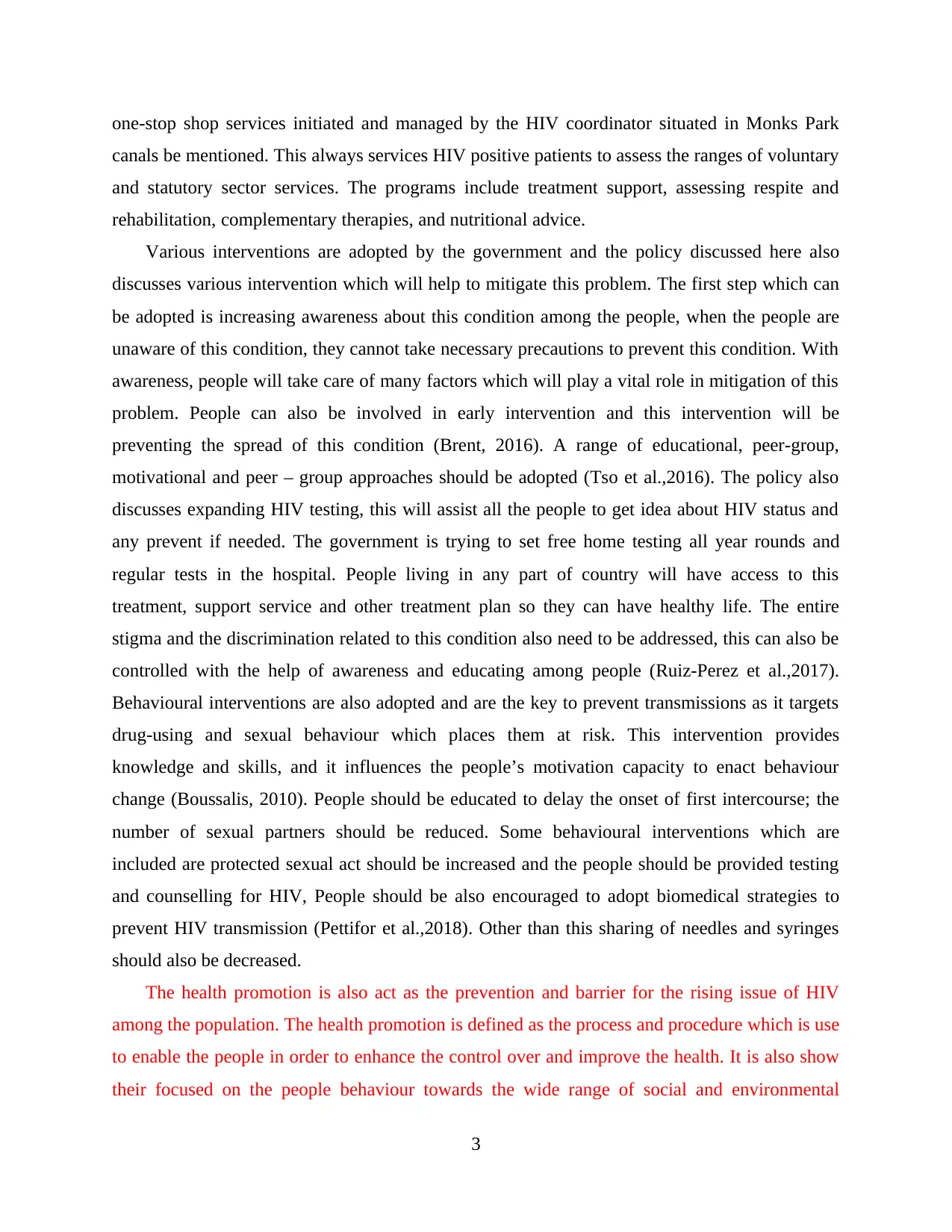
one-stop shop services initiated and managed by the HIV coordinator situated in Monks Park
canals be mentioned. This always services HIV positive patients to assess the ranges of voluntary
and statutory sector services. The programs include treatment support, assessing respite and
rehabilitation, complementary therapies, and nutritional advice.
Various interventions are adopted by the government and the policy discussed here also
discusses various intervention which will help to mitigate this problem. The first step which can
be adopted is increasing awareness about this condition among the people, when the people are
unaware of this condition, they cannot take necessary precautions to prevent this condition. With
awareness, people will take care of many factors which will play a vital role in mitigation of this
problem. People can also be involved in early intervention and this intervention will be
preventing the spread of this condition (Brent, 2016). A range of educational, peer-group,
motivational and peer – group approaches should be adopted (Tso et al.,2016). The policy also
discusses expanding HIV testing, this will assist all the people to get idea about HIV status and
any prevent if needed. The government is trying to set free home testing all year rounds and
regular tests in the hospital. People living in any part of country will have access to this
treatment, support service and other treatment plan so they can have healthy life. The entire
stigma and the discrimination related to this condition also need to be addressed, this can also be
controlled with the help of awareness and educating among people (Ruiz-Perez et al.,2017).
Behavioural interventions are also adopted and are the key to prevent transmissions as it targets
drug-using and sexual behaviour which places them at risk. This intervention provides
knowledge and skills, and it influences the people’s motivation capacity to enact behaviour
change (Boussalis, 2010). People should be educated to delay the onset of first intercourse; the
number of sexual partners should be reduced. Some behavioural interventions which are
included are protected sexual act should be increased and the people should be provided testing
and counselling for HIV, People should be also encouraged to adopt biomedical strategies to
prevent HIV transmission (Pettifor et al.,2018). Other than this sharing of needles and syringes
should also be decreased.
The health promotion is also act as the prevention and barrier for the rising issue of HIV
among the population. The health promotion is defined as the process and procedure which is use
to enable the people in order to enhance the control over and improve the health. It is also show
their focused on the people behaviour towards the wide range of social and environmental
3
canals be mentioned. This always services HIV positive patients to assess the ranges of voluntary
and statutory sector services. The programs include treatment support, assessing respite and
rehabilitation, complementary therapies, and nutritional advice.
Various interventions are adopted by the government and the policy discussed here also
discusses various intervention which will help to mitigate this problem. The first step which can
be adopted is increasing awareness about this condition among the people, when the people are
unaware of this condition, they cannot take necessary precautions to prevent this condition. With
awareness, people will take care of many factors which will play a vital role in mitigation of this
problem. People can also be involved in early intervention and this intervention will be
preventing the spread of this condition (Brent, 2016). A range of educational, peer-group,
motivational and peer – group approaches should be adopted (Tso et al.,2016). The policy also
discusses expanding HIV testing, this will assist all the people to get idea about HIV status and
any prevent if needed. The government is trying to set free home testing all year rounds and
regular tests in the hospital. People living in any part of country will have access to this
treatment, support service and other treatment plan so they can have healthy life. The entire
stigma and the discrimination related to this condition also need to be addressed, this can also be
controlled with the help of awareness and educating among people (Ruiz-Perez et al.,2017).
Behavioural interventions are also adopted and are the key to prevent transmissions as it targets
drug-using and sexual behaviour which places them at risk. This intervention provides
knowledge and skills, and it influences the people’s motivation capacity to enact behaviour
change (Boussalis, 2010). People should be educated to delay the onset of first intercourse; the
number of sexual partners should be reduced. Some behavioural interventions which are
included are protected sexual act should be increased and the people should be provided testing
and counselling for HIV, People should be also encouraged to adopt biomedical strategies to
prevent HIV transmission (Pettifor et al.,2018). Other than this sharing of needles and syringes
should also be decreased.
The health promotion is also act as the prevention and barrier for the rising issue of HIV
among the population. The health promotion is defined as the process and procedure which is use
to enable the people in order to enhance the control over and improve the health. It is also show
their focused on the people behaviour towards the wide range of social and environmental
3
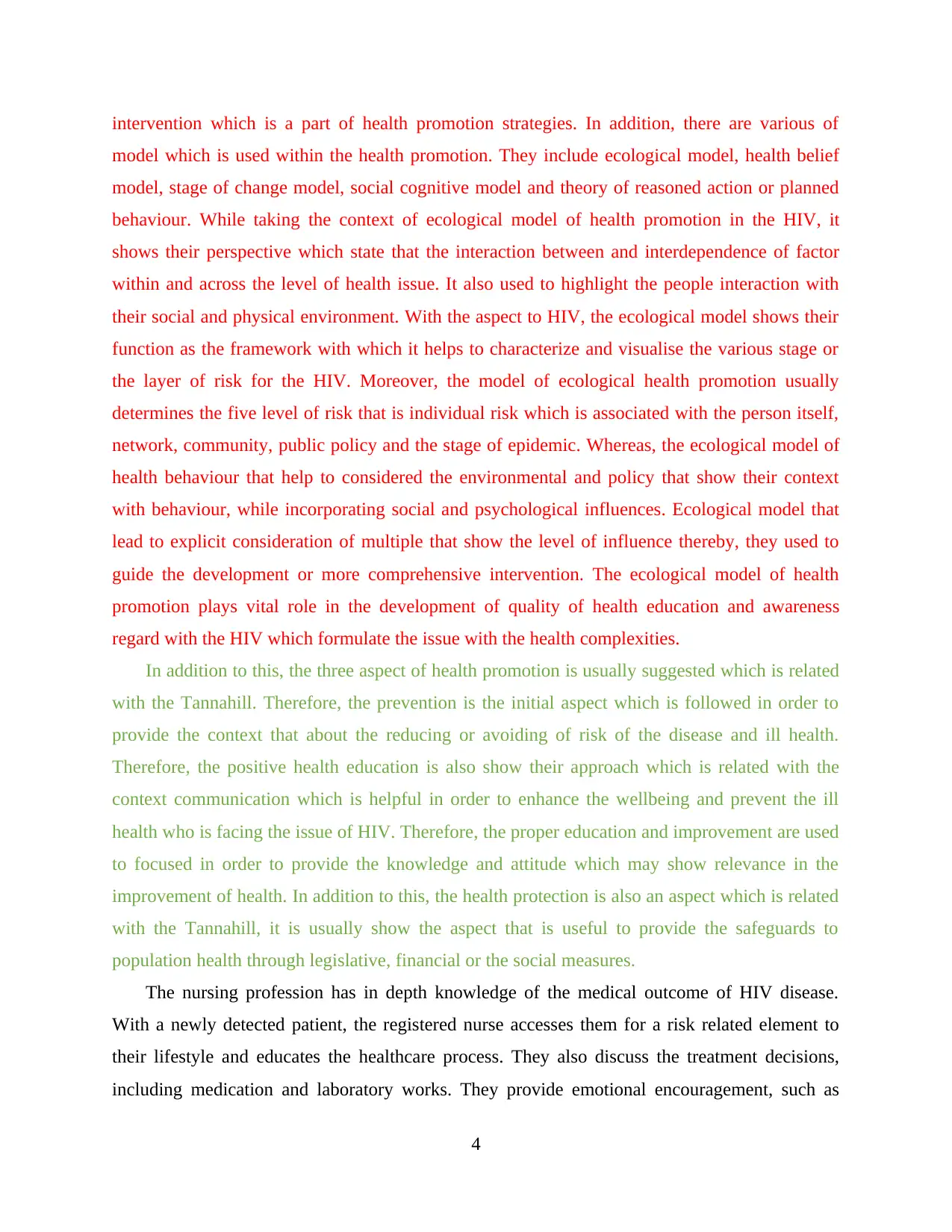
intervention which is a part of health promotion strategies. In addition, there are various of
model which is used within the health promotion. They include ecological model, health belief
model, stage of change model, social cognitive model and theory of reasoned action or planned
behaviour. While taking the context of ecological model of health promotion in the HIV, it
shows their perspective which state that the interaction between and interdependence of factor
within and across the level of health issue. It also used to highlight the people interaction with
their social and physical environment. With the aspect to HIV, the ecological model shows their
function as the framework with which it helps to characterize and visualise the various stage or
the layer of risk for the HIV. Moreover, the model of ecological health promotion usually
determines the five level of risk that is individual risk which is associated with the person itself,
network, community, public policy and the stage of epidemic. Whereas, the ecological model of
health behaviour that help to considered the environmental and policy that show their context
with behaviour, while incorporating social and psychological influences. Ecological model that
lead to explicit consideration of multiple that show the level of influence thereby, they used to
guide the development or more comprehensive intervention. The ecological model of health
promotion plays vital role in the development of quality of health education and awareness
regard with the HIV which formulate the issue with the health complexities.
In addition to this, the three aspect of health promotion is usually suggested which is related
with the Tannahill. Therefore, the prevention is the initial aspect which is followed in order to
provide the context that about the reducing or avoiding of risk of the disease and ill health.
Therefore, the positive health education is also show their approach which is related with the
context communication which is helpful in order to enhance the wellbeing and prevent the ill
health who is facing the issue of HIV. Therefore, the proper education and improvement are used
to focused in order to provide the knowledge and attitude which may show relevance in the
improvement of health. In addition to this, the health protection is also an aspect which is related
with the Tannahill, it is usually show the aspect that is useful to provide the safeguards to
population health through legislative, financial or the social measures.
The nursing profession has in depth knowledge of the medical outcome of HIV disease.
With a newly detected patient, the registered nurse accesses them for a risk related element to
their lifestyle and educates the healthcare process. They also discuss the treatment decisions,
including medication and laboratory works. They provide emotional encouragement, such as
4
model which is used within the health promotion. They include ecological model, health belief
model, stage of change model, social cognitive model and theory of reasoned action or planned
behaviour. While taking the context of ecological model of health promotion in the HIV, it
shows their perspective which state that the interaction between and interdependence of factor
within and across the level of health issue. It also used to highlight the people interaction with
their social and physical environment. With the aspect to HIV, the ecological model shows their
function as the framework with which it helps to characterize and visualise the various stage or
the layer of risk for the HIV. Moreover, the model of ecological health promotion usually
determines the five level of risk that is individual risk which is associated with the person itself,
network, community, public policy and the stage of epidemic. Whereas, the ecological model of
health behaviour that help to considered the environmental and policy that show their context
with behaviour, while incorporating social and psychological influences. Ecological model that
lead to explicit consideration of multiple that show the level of influence thereby, they used to
guide the development or more comprehensive intervention. The ecological model of health
promotion plays vital role in the development of quality of health education and awareness
regard with the HIV which formulate the issue with the health complexities.
In addition to this, the three aspect of health promotion is usually suggested which is related
with the Tannahill. Therefore, the prevention is the initial aspect which is followed in order to
provide the context that about the reducing or avoiding of risk of the disease and ill health.
Therefore, the positive health education is also show their approach which is related with the
context communication which is helpful in order to enhance the wellbeing and prevent the ill
health who is facing the issue of HIV. Therefore, the proper education and improvement are used
to focused in order to provide the knowledge and attitude which may show relevance in the
improvement of health. In addition to this, the health protection is also an aspect which is related
with the Tannahill, it is usually show the aspect that is useful to provide the safeguards to
population health through legislative, financial or the social measures.
The nursing profession has in depth knowledge of the medical outcome of HIV disease.
With a newly detected patient, the registered nurse accesses them for a risk related element to
their lifestyle and educates the healthcare process. They also discuss the treatment decisions,
including medication and laboratory works. They provide emotional encouragement, such as
4
⊘ This is a preview!⊘
Do you want full access?
Subscribe today to unlock all pages.

Trusted by 1+ million students worldwide

referring them to counselling according to the agreeable patient (Johnson et al., 2014). Overall,
they play a role in creating awareness about the disease and how they are transmitted gradually
(Rouleau et al., 2019). The prevention activities are not in the hands of nursing professionals; by
they can only educate the potentially effected member with possible methods. They play a role in
promoting health policies among community members at risk. Nursing professionals align their
skills with the challenging availability of resources and maintained improved service methods
every time. The nurse has already developed reputation and values (Witzel et al., 2016). This is
the reason they have become an effective health educator and health promoter (Frain, 2017). In
Brent, several local organizations and centres provide services for which the patients need to
book an appointment so they can visit to consult physicians. Health education, especially related
to HIV, is available in this hospital, making the services more patient orientated and effective.
The patient can be convinced by a nursing professional compared to the other health educator.
Therefore, more information is the campaign to achieve zero HIV zero transmission by 2030.
The nursing professional in these hospitals in Brent borough has the knowledge of emergency
HIV drug and laboratory support, which empowers the patient already suffering from the disease
to recover quickly. The goal of zero transmission can only be implemented with the support of a
nursing professional, otherwise it can take time and effort to create health related awareness. The
health educator can reach rural and remote areas, and enhanced health literacy among people, but
the same activities performed by the nurse will achieve more targets. It is easy for them to
convince community members to have behavioural change. The care provider develops a reliable
relationship with the patient and can be pointed out their perspectives to learn about HIV disease.
In addition, contraceptive services are available in Brent borough. The common people can visit
the walk-in clinic of Wembley centre for health and care. There are several GPs to deliver a
range venue so that poverty-stricken communities like outreach workers, homeless people, and
black communities with less educational qualification. The authorities of this borough have also
started a website to provide all round facilities to the citizen. The citizen under 20s gets a free
condom card. So that transmission of this disease through unprotected teenage sex is reduced.
Along with thus, contraceptive service has also included vulnerable young people.
CONCLUSION
As per the above discussion, it has been observed that many populations have be affected by
this HIV. The prevalence rate is around 3.1 in 1000 which implies that about 94% of the people
5
they play a role in creating awareness about the disease and how they are transmitted gradually
(Rouleau et al., 2019). The prevention activities are not in the hands of nursing professionals; by
they can only educate the potentially effected member with possible methods. They play a role in
promoting health policies among community members at risk. Nursing professionals align their
skills with the challenging availability of resources and maintained improved service methods
every time. The nurse has already developed reputation and values (Witzel et al., 2016). This is
the reason they have become an effective health educator and health promoter (Frain, 2017). In
Brent, several local organizations and centres provide services for which the patients need to
book an appointment so they can visit to consult physicians. Health education, especially related
to HIV, is available in this hospital, making the services more patient orientated and effective.
The patient can be convinced by a nursing professional compared to the other health educator.
Therefore, more information is the campaign to achieve zero HIV zero transmission by 2030.
The nursing professional in these hospitals in Brent borough has the knowledge of emergency
HIV drug and laboratory support, which empowers the patient already suffering from the disease
to recover quickly. The goal of zero transmission can only be implemented with the support of a
nursing professional, otherwise it can take time and effort to create health related awareness. The
health educator can reach rural and remote areas, and enhanced health literacy among people, but
the same activities performed by the nurse will achieve more targets. It is easy for them to
convince community members to have behavioural change. The care provider develops a reliable
relationship with the patient and can be pointed out their perspectives to learn about HIV disease.
In addition, contraceptive services are available in Brent borough. The common people can visit
the walk-in clinic of Wembley centre for health and care. There are several GPs to deliver a
range venue so that poverty-stricken communities like outreach workers, homeless people, and
black communities with less educational qualification. The authorities of this borough have also
started a website to provide all round facilities to the citizen. The citizen under 20s gets a free
condom card. So that transmission of this disease through unprotected teenage sex is reduced.
Along with thus, contraceptive service has also included vulnerable young people.
CONCLUSION
As per the above discussion, it has been observed that many populations have be affected by
this HIV. The prevalence rate is around 3.1 in 1000 which implies that about 94% of the people
5
Paraphrase This Document
Need a fresh take? Get an instant paraphrase of this document with our AI Paraphraser
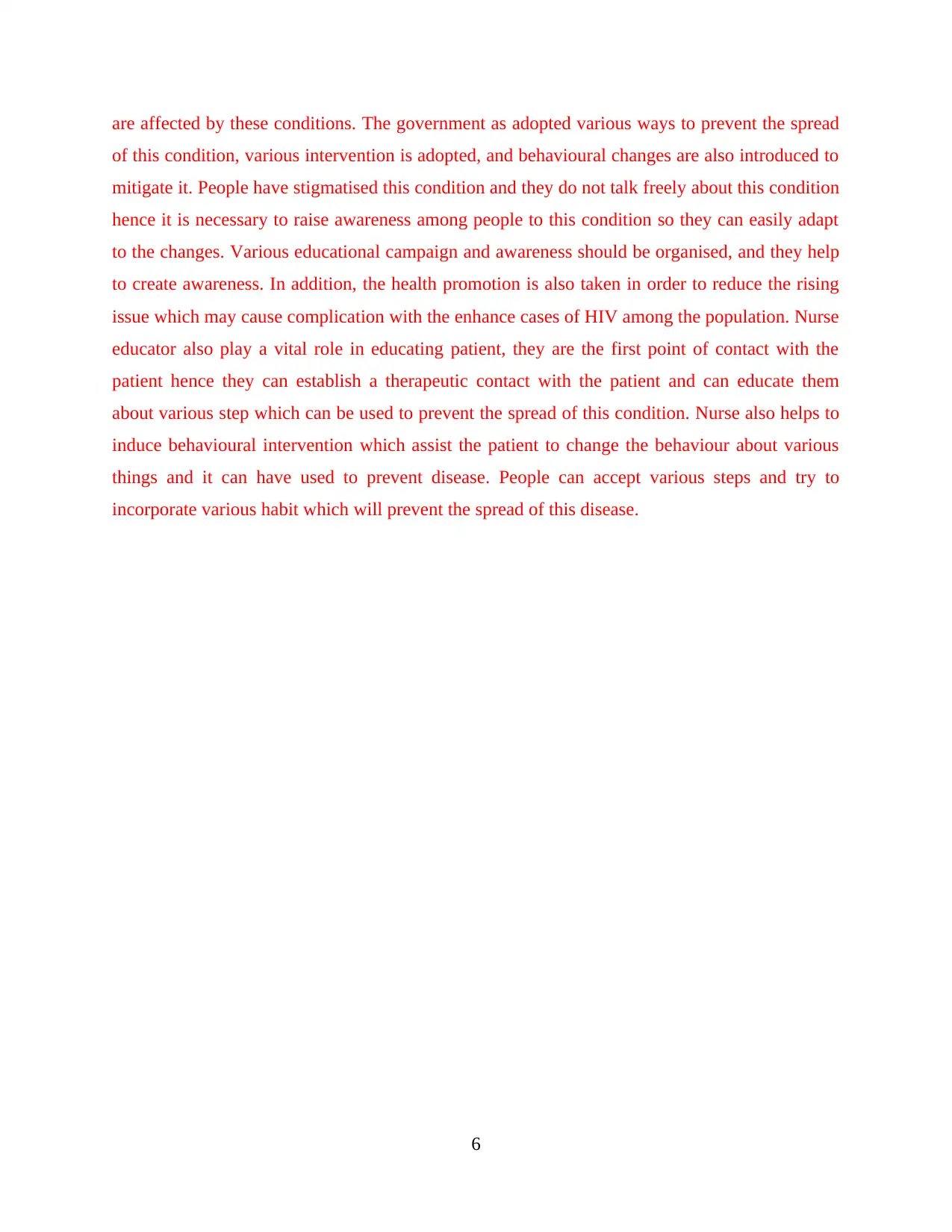
are affected by these conditions. The government as adopted various ways to prevent the spread
of this condition, various intervention is adopted, and behavioural changes are also introduced to
mitigate it. People have stigmatised this condition and they do not talk freely about this condition
hence it is necessary to raise awareness among people to this condition so they can easily adapt
to the changes. Various educational campaign and awareness should be organised, and they help
to create awareness. In addition, the health promotion is also taken in order to reduce the rising
issue which may cause complication with the enhance cases of HIV among the population. Nurse
educator also play a vital role in educating patient, they are the first point of contact with the
patient hence they can establish a therapeutic contact with the patient and can educate them
about various step which can be used to prevent the spread of this condition. Nurse also helps to
induce behavioural intervention which assist the patient to change the behaviour about various
things and it can have used to prevent disease. People can accept various steps and try to
incorporate various habit which will prevent the spread of this disease.
6
of this condition, various intervention is adopted, and behavioural changes are also introduced to
mitigate it. People have stigmatised this condition and they do not talk freely about this condition
hence it is necessary to raise awareness among people to this condition so they can easily adapt
to the changes. Various educational campaign and awareness should be organised, and they help
to create awareness. In addition, the health promotion is also taken in order to reduce the rising
issue which may cause complication with the enhance cases of HIV among the population. Nurse
educator also play a vital role in educating patient, they are the first point of contact with the
patient hence they can establish a therapeutic contact with the patient and can educate them
about various step which can be used to prevent the spread of this condition. Nurse also helps to
induce behavioural intervention which assist the patient to change the behaviour about various
things and it can have used to prevent disease. People can accept various steps and try to
incorporate various habit which will prevent the spread of this disease.
6
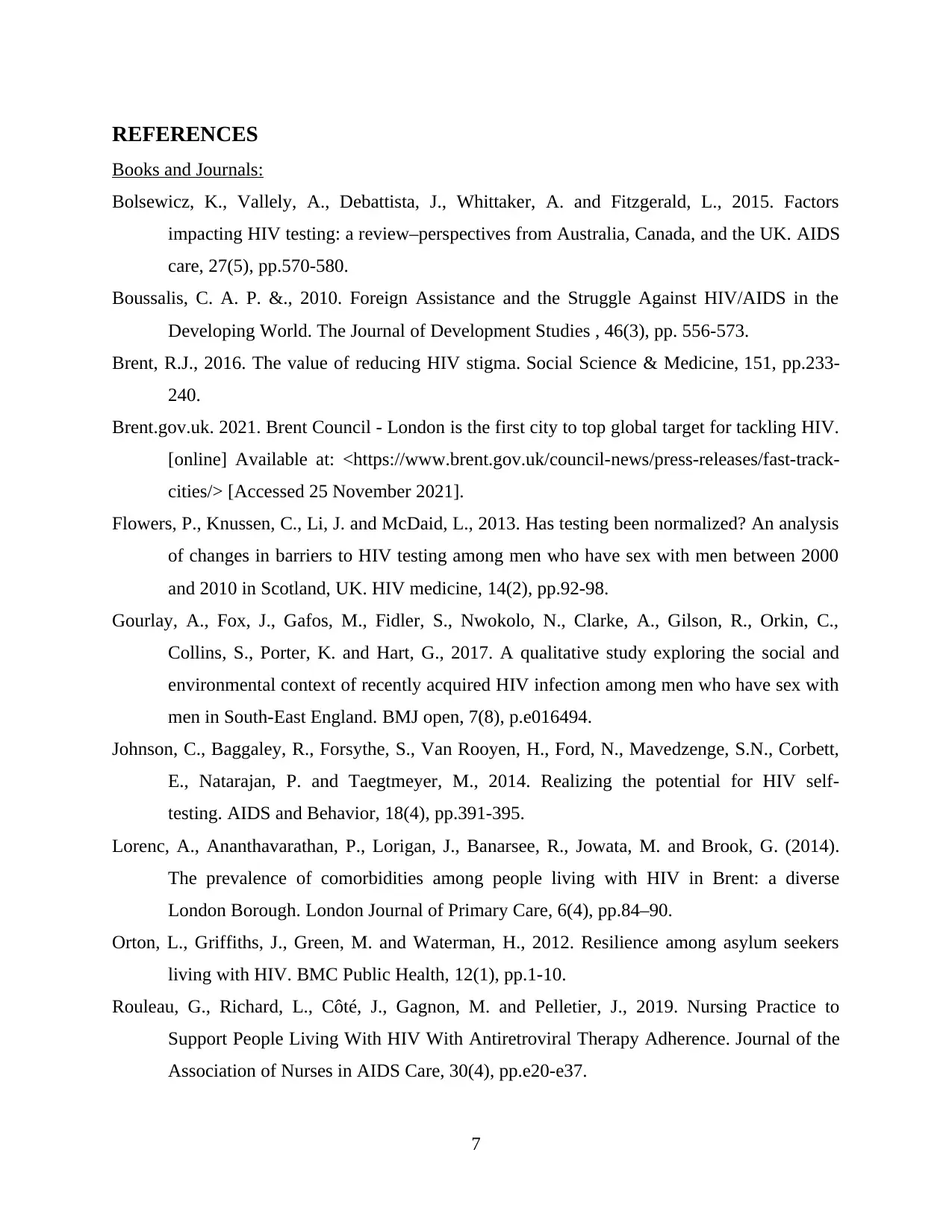
REFERENCES
Books and Journals:
Bolsewicz, K., Vallely, A., Debattista, J., Whittaker, A. and Fitzgerald, L., 2015. Factors
impacting HIV testing: a review–perspectives from Australia, Canada, and the UK. AIDS
care, 27(5), pp.570-580.
Boussalis, C. A. P. &., 2010. Foreign Assistance and the Struggle Against HIV/AIDS in the
Developing World. The Journal of Development Studies , 46(3), pp. 556-573.
Brent, R.J., 2016. The value of reducing HIV stigma. Social Science & Medicine, 151, pp.233-
240.
Brent.gov.uk. 2021. Brent Council - London is the first city to top global target for tackling HIV.
[online] Available at: <https://www.brent.gov.uk/council-news/press-releases/fast-track-
cities/> [Accessed 25 November 2021].
Flowers, P., Knussen, C., Li, J. and McDaid, L., 2013. Has testing been normalized? An analysis
of changes in barriers to HIV testing among men who have sex with men between 2000
and 2010 in Scotland, UK. HIV medicine, 14(2), pp.92-98.
Gourlay, A., Fox, J., Gafos, M., Fidler, S., Nwokolo, N., Clarke, A., Gilson, R., Orkin, C.,
Collins, S., Porter, K. and Hart, G., 2017. A qualitative study exploring the social and
environmental context of recently acquired HIV infection among men who have sex with
men in South-East England. BMJ open, 7(8), p.e016494.
Johnson, C., Baggaley, R., Forsythe, S., Van Rooyen, H., Ford, N., Mavedzenge, S.N., Corbett,
E., Natarajan, P. and Taegtmeyer, M., 2014. Realizing the potential for HIV self-
testing. AIDS and Behavior, 18(4), pp.391-395.
Lorenc, A., Ananthavarathan, P., Lorigan, J., Banarsee, R., Jowata, M. and Brook, G. (2014).
The prevalence of comorbidities among people living with HIV in Brent: a diverse
London Borough. London Journal of Primary Care, 6(4), pp.84–90.
Orton, L., Griffiths, J., Green, M. and Waterman, H., 2012. Resilience among asylum seekers
living with HIV. BMC Public Health, 12(1), pp.1-10.
Rouleau, G., Richard, L., Côté, J., Gagnon, M. and Pelletier, J., 2019. Nursing Practice to
Support People Living With HIV With Antiretroviral Therapy Adherence. Journal of the
Association of Nurses in AIDS Care, 30(4), pp.e20-e37.
7
Books and Journals:
Bolsewicz, K., Vallely, A., Debattista, J., Whittaker, A. and Fitzgerald, L., 2015. Factors
impacting HIV testing: a review–perspectives from Australia, Canada, and the UK. AIDS
care, 27(5), pp.570-580.
Boussalis, C. A. P. &., 2010. Foreign Assistance and the Struggle Against HIV/AIDS in the
Developing World. The Journal of Development Studies , 46(3), pp. 556-573.
Brent, R.J., 2016. The value of reducing HIV stigma. Social Science & Medicine, 151, pp.233-
240.
Brent.gov.uk. 2021. Brent Council - London is the first city to top global target for tackling HIV.
[online] Available at: <https://www.brent.gov.uk/council-news/press-releases/fast-track-
cities/> [Accessed 25 November 2021].
Flowers, P., Knussen, C., Li, J. and McDaid, L., 2013. Has testing been normalized? An analysis
of changes in barriers to HIV testing among men who have sex with men between 2000
and 2010 in Scotland, UK. HIV medicine, 14(2), pp.92-98.
Gourlay, A., Fox, J., Gafos, M., Fidler, S., Nwokolo, N., Clarke, A., Gilson, R., Orkin, C.,
Collins, S., Porter, K. and Hart, G., 2017. A qualitative study exploring the social and
environmental context of recently acquired HIV infection among men who have sex with
men in South-East England. BMJ open, 7(8), p.e016494.
Johnson, C., Baggaley, R., Forsythe, S., Van Rooyen, H., Ford, N., Mavedzenge, S.N., Corbett,
E., Natarajan, P. and Taegtmeyer, M., 2014. Realizing the potential for HIV self-
testing. AIDS and Behavior, 18(4), pp.391-395.
Lorenc, A., Ananthavarathan, P., Lorigan, J., Banarsee, R., Jowata, M. and Brook, G. (2014).
The prevalence of comorbidities among people living with HIV in Brent: a diverse
London Borough. London Journal of Primary Care, 6(4), pp.84–90.
Orton, L., Griffiths, J., Green, M. and Waterman, H., 2012. Resilience among asylum seekers
living with HIV. BMC Public Health, 12(1), pp.1-10.
Rouleau, G., Richard, L., Côté, J., Gagnon, M. and Pelletier, J., 2019. Nursing Practice to
Support People Living With HIV With Antiretroviral Therapy Adherence. Journal of the
Association of Nurses in AIDS Care, 30(4), pp.e20-e37.
7
⊘ This is a preview!⊘
Do you want full access?
Subscribe today to unlock all pages.

Trusted by 1+ million students worldwide
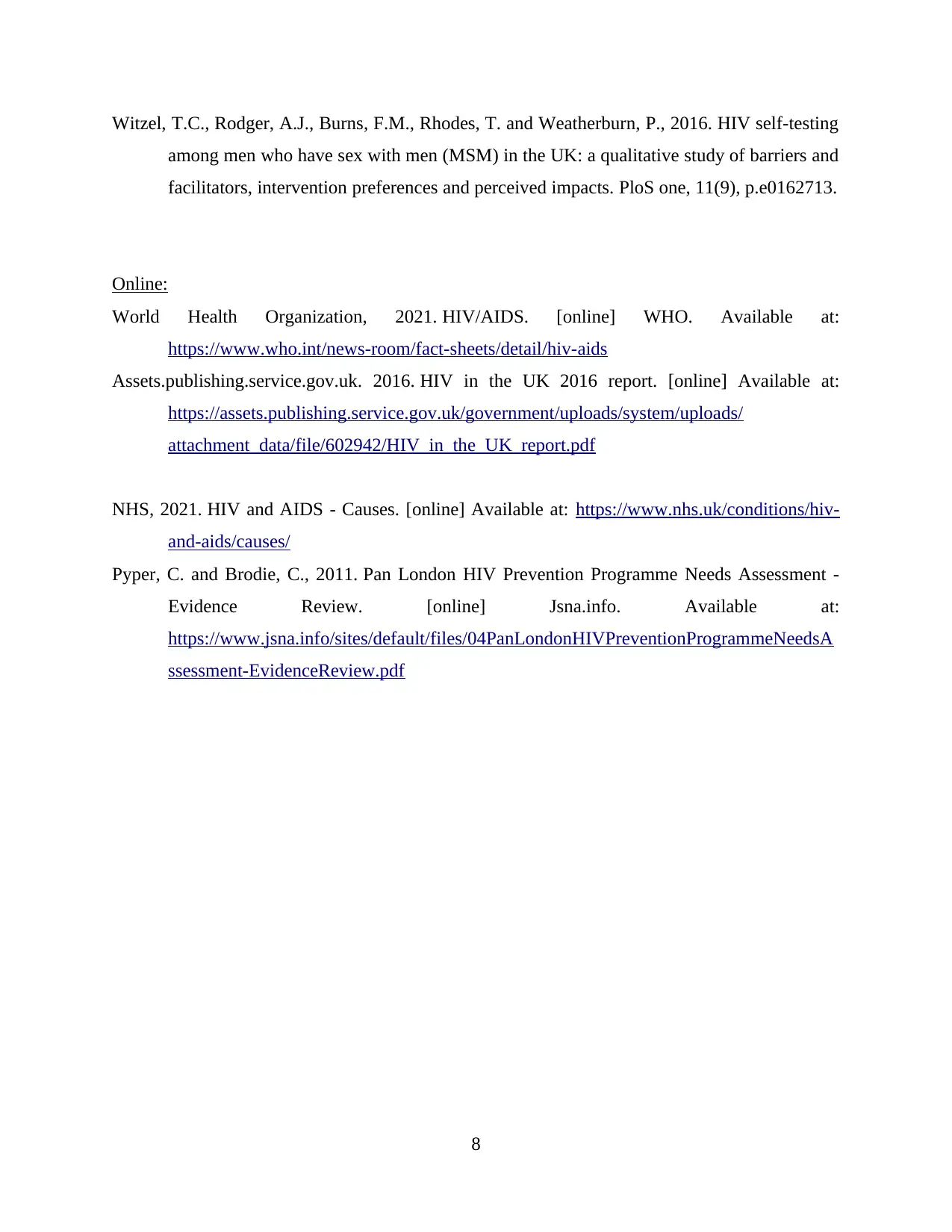
Witzel, T.C., Rodger, A.J., Burns, F.M., Rhodes, T. and Weatherburn, P., 2016. HIV self-testing
among men who have sex with men (MSM) in the UK: a qualitative study of barriers and
facilitators, intervention preferences and perceived impacts. PloS one, 11(9), p.e0162713.
Online:
World Health Organization, 2021. HIV/AIDS. [online] WHO. Available at:
https://www.who.int/news-room/fact-sheets/detail/hiv-aids
Assets.publishing.service.gov.uk. 2016. HIV in the UK 2016 report. [online] Available at:
https://assets.publishing.service.gov.uk/government/uploads/system/uploads/
attachment_data/file/602942/HIV_in_the_UK_report.pdf
NHS, 2021. HIV and AIDS - Causes. [online] Available at: https://www.nhs.uk/conditions/hiv-
and-aids/causes/
Pyper, C. and Brodie, C., 2011. Pan London HIV Prevention Programme Needs Assessment -
Evidence Review. [online] Jsna.info. Available at:
https://www.jsna.info/sites/default/files/04PanLondonHIVPreventionProgrammeNeedsA
ssessment-EvidenceReview.pdf
8
among men who have sex with men (MSM) in the UK: a qualitative study of barriers and
facilitators, intervention preferences and perceived impacts. PloS one, 11(9), p.e0162713.
Online:
World Health Organization, 2021. HIV/AIDS. [online] WHO. Available at:
https://www.who.int/news-room/fact-sheets/detail/hiv-aids
Assets.publishing.service.gov.uk. 2016. HIV in the UK 2016 report. [online] Available at:
https://assets.publishing.service.gov.uk/government/uploads/system/uploads/
attachment_data/file/602942/HIV_in_the_UK_report.pdf
NHS, 2021. HIV and AIDS - Causes. [online] Available at: https://www.nhs.uk/conditions/hiv-
and-aids/causes/
Pyper, C. and Brodie, C., 2011. Pan London HIV Prevention Programme Needs Assessment -
Evidence Review. [online] Jsna.info. Available at:
https://www.jsna.info/sites/default/files/04PanLondonHIVPreventionProgrammeNeedsA
ssessment-EvidenceReview.pdf
8
1 out of 10
Related Documents
Your All-in-One AI-Powered Toolkit for Academic Success.
+13062052269
info@desklib.com
Available 24*7 on WhatsApp / Email
![[object Object]](/_next/static/media/star-bottom.7253800d.svg)
Unlock your academic potential
Copyright © 2020–2025 A2Z Services. All Rights Reserved. Developed and managed by ZUCOL.





